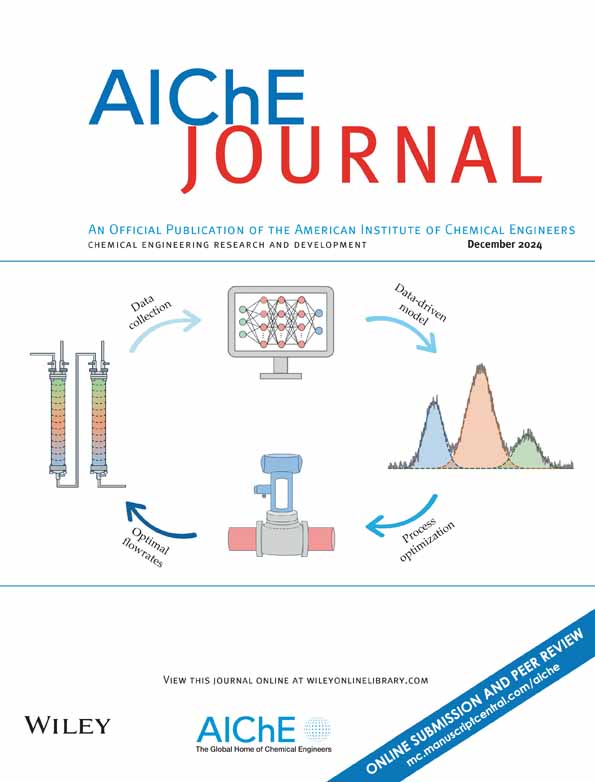π-Electron-driven ionic liquids to enhance lithium recovery from spent batteries: Experimental and mechanistic insights
IF 3.5
3区 工程技术
Q2 ENGINEERING, CHEMICAL
引用次数: 0
Abstract
A novel strategy is proposed to enhance Li+ extraction from spent lithium-ion batteries (LIBs) by ionic liquid (IL)-based extractants with π-electron regulation. N-butyl-4-methylpyridinium bis(trifluoromethylsulfonyl)imide ([BMPy][Tf2N]) + tributyl phosphate (TBP) was designed as an optimal extractant resulting in extraction efficiency of Li+ up to 98.4%, separation selectivities of Li+ over other ions βLi+/Co2+, βLi+/Ni2+, and βLi+/Mn2+ up to 705, 740, and 663, respectively, and Li2CO3 product with 93.2 wt.% purity. The molecular-level mechanism for enhancing Li+ extraction was unraveled by quantum chemical calculations and molecular dynamics simulations. It is found that the [BMPy][Tf2N] + TBP system with moderate π-electron density is not able to disrupt the strong hydration of divalent metal ions Co2+, Ni2+ and Mn2+, but it can disrupt Li+ hydration by so-called the “π-electron density matching effect.” This work provides theoretical guidance for rational design of specific IL-based extractants to selective extraction of target metal ions from spent LIBs.π-电子驱动离子液体提高废电池中锂的回收:实验和机理见解
提出了一种利用离子液体萃取剂提高废旧锂离子电池中Li+萃取率的新策略。以n -丁基-4-甲基吡啶双(三氟甲基磺酰基)亚胺([BMPy][Tf2N]) +磷酸三丁酯(TBP)为最佳萃取剂,Li+对βLi+/Co2+、βLi+/Ni2+和βLi+/Mn2+离子的分离选择性分别为705、740和663,Li2CO3产物质量为93.2 wt。%纯度。通过量子化学计算和分子动力学模拟,揭示了增强Li+萃取的分子水平机制。发现π电子密度适中的[BMPy][Tf2N] + TBP体系不能破坏二价金属离子Co2+、Ni2+和Mn2+的强水化作用,但可以通过所谓的“π电子密度匹配效应”破坏Li+的水化作用。本研究为合理设计特定的il基萃取剂,选择性地从废lib中提取目标金属离子提供了理论指导。
本文章由计算机程序翻译,如有差异,请以英文原文为准。
求助全文
约1分钟内获得全文
求助全文
来源期刊

AIChE Journal
工程技术-工程:化工
CiteScore
7.10
自引率
10.80%
发文量
411
审稿时长
3.6 months
期刊介绍:
The AIChE Journal is the premier research monthly in chemical engineering and related fields. This peer-reviewed and broad-based journal reports on the most important and latest technological advances in core areas of chemical engineering as well as in other relevant engineering disciplines. To keep abreast with the progressive outlook of the profession, the Journal has been expanding the scope of its editorial contents to include such fast developing areas as biotechnology, electrochemical engineering, and environmental engineering.
The AIChE Journal is indeed the global communications vehicle for the world-renowned researchers to exchange top-notch research findings with one another. Subscribing to the AIChE Journal is like having immediate access to nine topical journals in the field.
Articles are categorized according to the following topical areas:
Biomolecular Engineering, Bioengineering, Biochemicals, Biofuels, and Food
Inorganic Materials: Synthesis and Processing
Particle Technology and Fluidization
Process Systems Engineering
Reaction Engineering, Kinetics and Catalysis
Separations: Materials, Devices and Processes
Soft Materials: Synthesis, Processing and Products
Thermodynamics and Molecular-Scale Phenomena
Transport Phenomena and Fluid Mechanics.
 求助内容:
求助内容: 应助结果提醒方式:
应助结果提醒方式:


